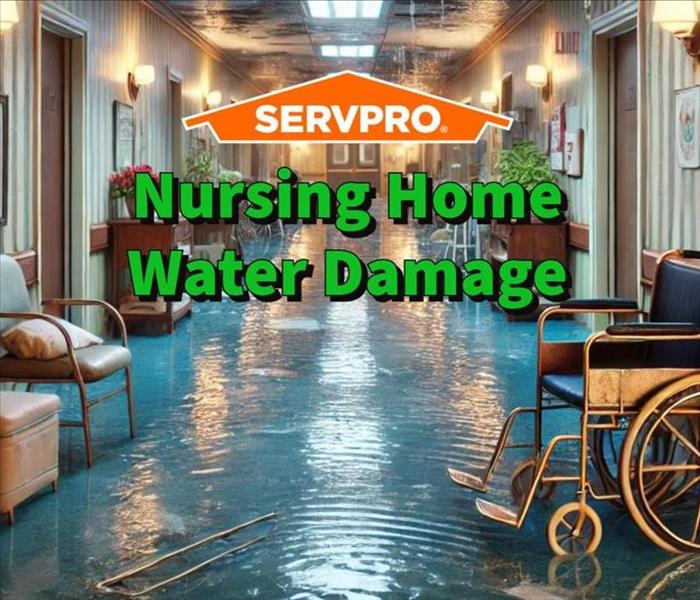Nursing Home Water Damage: #1 Ultimate Guide to Recovery
1/27/2025 (Permalink)
This resource about nursing home water damage offers expert insights and actionable steps to protect your facility from costly water-related incidents.
Nursing homes provide essential care and a safe environment for residents. Still, unexpected water damage can disrupt operations and compromise the well-being of occupants. Nursing home water damage poses significant challenges due to the facility's sensitive nature and the potential for extensive property damage.
This blog post will cover the common causes of nursing home water damage, practical prevention tips, and how SERVPRO® expertise can help restore affected facilities efficiently and effectively.
What are the common causes of nursing home water damage?
Nursing home water damage can result from various sources, many of which are preventable with proactive maintenance. The most common causes include:
- Plumbing Failures: Aging plumbing systems are prone to leaks and pipe bursts, especially in older facilities.
- Roof Leaks: Poor maintenance and seasonal weather changes can lead to roof deterioration, allowing water to seep into the structure.
- Appliance Malfunctions: Equipment such as water heaters, washing machines, and kitchen appliances can fail and cause water damage.
- HVAC System Issues: Improper drainage or clogged condensation lines can lead to water accumulation and damage.
- Natural Disasters: Heavy rains, floods, and storms can overwhelm nursing home drainage systems, causing significant water intrusion.
How can water damage affect nursing home operations?
Water damage in a nursing home can have far-reaching consequences, including:
- Operational Disruptions: Affected areas may need to be closed, leading to inconvenience for staff and residents.
- Structural Damage: Prolonged exposure to moisture can weaken building materials and infrastructure.
- Loss of Equipment: Essential medical and operational equipment may suffer irreversible damage.
- Reputation Risks: Failure to address water damage promptly can impact the facility's reputation and trust among families and stakeholders.
Tips to prevent nursing home water damage
Implementing preventive measures can help nursing homes minimize the risk of water damage. Here are practical steps to safeguard your facility:
- Regular Plumbing Inspections: Schedule routine plumbing checks to identify and address leaks or corrosion before they escalate.
- Maintain Roofing Systems: Regular inspections and maintenance can prevent leaks and ensure the roof is in good condition.
- Install Water Detection Devices: Early detection systems can alert staff to leaks or moisture buildup before extensive damage occurs.
- Ensure Proper Drainage: To prevent water overflow, keep gutters, downspouts, and drainage systems clear of debris.
- Monitor Appliance Performance: Regular servicing of water-dependent appliances can prevent unexpected malfunctions.
- Train Staff on Emergency Protocols: Educate staff on water damage prevention and emergency response procedures.
- Seal Vulnerable Areas: Inspect and seal gaps around doors, windows, and foundations to prevent water intrusion.
- Develop a Response Plan: Having a plan in place for quick action in the event of water damage can minimize disruptions.
A recent case of restoration after nursing home water damage
Last month, in Jefferson, Georgia, SERVPRO responded to an urgent call from a local nursing home experiencing significant water damage. A burst pipe in the laundry room caused extensive flooding, affecting several resident rooms and common areas.
Understanding the critical nature of the facility, our SERVPRO team arrived promptly and conducted a thorough assessment. We devised a customized action plan, including:
- Rapid Water Extraction: Using powerful extraction equipment, we removed standing water swiftly to prevent further damage.
- Comprehensive Drying and Dehumidification: Our team deployed advanced drying systems to remove all moisture from floors, walls, and furnishings.
- Content Restoration: We carefully assessed and restored valuable equipment and furnishings critical to the nursing home's operations.
- Structural Assessment: Ensuring the structural integrity of the building remains intact, preventing future vulnerabilities.
- Preventative Measures: We provided recommendations to enhance the facility's plumbing and water detection systems to prevent future incidents.
Our timely response and expertise helped restore the nursing home quickly, ensuring minimal disruption to residents and staff.
What should you do when you experience nursing home water damage?
When water damage occurs in a nursing home, immediate action is crucial to minimize the impact. Follow these steps:
- Stop the Water Source: If possible, shut off the water supply to prevent further flooding.
- Contact SERVPRO Immediately: Our professional team is available 24/7 to assess and address the damage.
- Remove Excess Water: If safe to do so, remove standing water using available equipment.
- Protect Valuable Assets: Relocate critical equipment and documents to a dry area.
- Document the Damage: Take photos and notes for insurance purposes.
Wrapping Up
Choosing SERVPRO for nursing home water damage restoration means partnering with experts who understand the urgency and sensitivity of such incidents. Our team offers rapid response, advanced technology, and tailored solutions to restore your facility efficiently.
With SERVPRO, nursing home operators can rest assured that their property is in expert hands. Whether dealing with minor leaks or significant flooding, our comprehensive approach ensures a thorough restoration process that prioritizes safety, efficiency, and peace of mind.
Water damage can be disruptive, but with the right prevention measures and SERVPRO's expertise, your nursing home can remain a safe and welcoming environment for residents and staff alike.

 24/7 Emergency Service
24/7 Emergency Service
